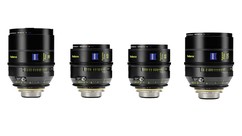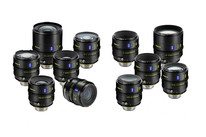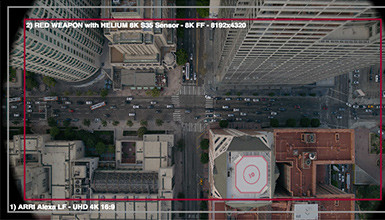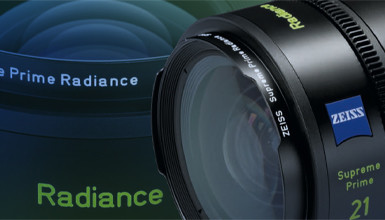Just like their non-Radiance siblings, the ZEISS Supreme Prime Radiance lenses all feature a T1.5 maximum aperture and image circles that go beyond even full format (also known as full frame) with a 46.3mm diameter. All are also consistent in their focus and iris geared ring locations and most have the same 95mm outer diameter fronts (the 18mm and 135mm are both 114m), just like the standard Supremes. Visually, they’re distinguished from standard Supreme primes by the barrel marking (‘Radiance’) and a gold-colored retaining ring in front of the PL-mount flanges.
In this blog, I’ll take a look at how a DP can employ these special lenses in order to create unique and expressive shots full of “character.” I’ll also address some misconceptions about the lenses, and full frame lenses generally, that may trip folks up when selecting a lens package for a project. Be sure to watch the videos to see visual examples of the information we’ll explore.
Supreme Prime Radiance in Use
Vintage lenses feature older coatings that provoke a variety of sometimes desirable (and sometimes not) flare or ghosting behavior, as well as reduce contrast, while modern lenses sometimes offer minor tweaks to create more flares (such as simply uncoating the front element). ZEISS Supreme Prime Radiance lenses contain the best of both worlds. They give the option of provoking highly stylized blue flares when used with light sources in (or adjacent to) the frame or minimizing flare behavior for a largely unmodified look reminiscent of the standard Supreme Primes.
The Radiance Primes present zones of control of their flaring behavior that coincide with a range of orientations to both light sources and the subject. Through different staging and testing approaches, it’s easy to find the “sweet spot” to create just the look you want for a particular shot. Megan Donnelly, who is AbelCine’s Director of Production Services as well as a Local 600 DP, filmed three different scenarios to explore and illustrate just how controllable the Supreme Radiances’ flare behavior is.
Megan says, “I was most struck by how you have to take a little time to find the ‘sweet spot’ to provoke the flares on the Supreme Prime Radiance lenses. It’s not like you point them anywhere in your scene and they automatically flare; you’re not going to get hit over the head by it.”
In the first sequence, we see how the Supreme Prime Radiance behave in an extreme contra-jour (backlight) scenario proved useful as well. Says Megan: “Shooting directly into the sun, and intentionally over exposing, showed how the T* Blue coatings don’t just render a single hue. Varying the angle of reflection from the sun allowed us to pull out a range of colors, from more vibrant purples to even amber tones, which provided a really organic feel. To enhance this, we used a #1 Coral filter on the Radiance.”
In another sequence, shot “dusk for night,” a mysterious rider arrives on a motorcycle before transitioning to a nightclub scene. “For the arrival, we weren’t planning to use any lights other than the practical motorcycle headlamp. I expected that the flares would be hard to control but I loved how it could be taken from a more subtle bloom, which also reduced contrast, to more traditional flaring just by some small moves of the camera and/or light source. It really allowed me to control its overall contribution to the scene.”
Once inside in the nightclub set, the background light was matched to the dominant T* Blue coating hue, to augment it. Using different focal lengths in the sequence proved straightforward. “Once you lock in the look you want, if you want to go tighter it’s easy to ‘re-find’ the sweet spot to achieve the same effect. In this way, we found the Supreme Prime Radiance to be very consistent across the range of focal lengths available – and they’re not going to slow you down,” says Megan.
Finally, a night exterior sequence, incorporating various street lights and marquees in Hollywood, provided more data about the lens’ behavior in an uncontrolled setting. Megan says, “It was interesting because only practical fixtures were used. We had no control over the lighting, so I was expecting them to flare more than they did. They held really nicely, even going from out-of-focus to in-focus, and some sources seemed to flare more, or differently, than others. Street lights provoked more flaring than signage or other environmental lighting. These showed more of that subtle ‘bloom’ I was talking about earlier.”
The bottom line regarding the flare behavior of the Supreme Prime Radiance could perhaps be best summed up in one word: controllable. The lenses provide a unique range of effects, from a subtle “wash” over the scene and reduced contrast, to graphic or abstract flare shapes when shot against point sources. Their contributions to the scene were able to be managed easily, and consistently, even without much prior familiarity with the lenses.
In all, we found the ZEISS Supreme Prime Radiance lenses to provide a unique rendering, with all of the qualities we love about their non-Radiance Supreme Prime siblings, but with a special character. The flare behavior was easy to provoke when we wanted it and, unlike with vintage lenses, just as easy to avoid when appropriate. The Radiance primes are a special set of lenses that won't be appropriate for every project but present a compelling option to cinematographers when exploring creative, stylized looks.





















AbelCine encourages comments on our blog posts, as long as they are relevant and respectful in tone. To further professional dialog, we strongly encourage the use of real names. We reserve the right to remove any comments that violate our comment policy.
AbelCine publishes this blog as a free educational resource, and anyone may read the discussions posted here. However, if you want to join the conversation, please log in or register on our site.
We use Disqus to manage comments on this blog. If you already have a Disqus account registered under the same email as your AbelCine account, you will automatically be logged in when you sign in to our site. If not, please create a free account with Disqus using the same email as your AbelCine account.